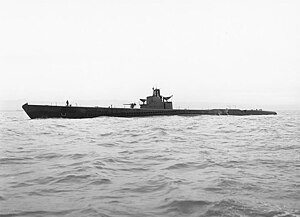USS Stingray (SS-186)
 |
|
| History | |
|---|---|
| Builder: | Portsmouth Naval Shipyard, Kittery, Maine |
| Laid down: | 1 October 1936 |
| Launched: | 6 October 1937 |
| Commissioned: | 15 March 1938 |
| Decommissioned: | 17 October 1945 |
| Struck: | 1 November 1945, then reinstated 28 November 1945, then struck again 3 July 1946 |
| Fate: | Sold for scrap, 6 January 1947 |
| General characteristics | |
| Class and type: | Salmon-class composite diesel-hydraulic and diesel-electric submarine |
| Displacement: | |
| Length: | 308 ft 0 in (93.88 m) |
| Beam: | 26 ft 1 1⁄4 in (7.957 m) |
| Draft: | 15 ft 8 in (4.78 m) |
| Propulsion: |
|
| Speed: |
|
| Range: | 11,000 nautical miles (20,000 km) at 10 knots (19 km/h) |
| Endurance: | 48 hours at 2 knots (3.7 km/h) submerged |
| Test depth: | 250 ft (76 m) |
| Complement: | 5 officers, 54 enlisted |
| Armament: | |
USS Stingray (SS-186), a Salmon-class submarine, was the second ship of the United States Navy to be named for the stingray, which is a large ray with a whiplike tail and sharp spines capable of inflicting severe wounds. Her keel was laid down by the Portsmouth Navy Yard on 1 October 1936. She was launched on 6 October 1937 sponsored by Mrs. Olive G. McLean, widow of Rear Admiral Ridley McLean, who had had a distinguished career in the submarine service, and was commissioned on 15 March 1938 with Lieutenant L. N. Blair in command.
Following shakedown off New England and in the Caribbean Sea, Stingray entered Portsmouth Navy Yard for alterations and upon completion on 14 January 1939, departed for a cruise in Caribbean waters. After briefly stopping at New London, Connecticut, on 20 April the submarine transited the Panama Canal and arrived at San Diego, California, on 11 May for a rigorous schedule of training and maneuvers as a unit of Submarine Squadron 6. She put to sea on 1 April 1940 for fleet exercises in the Hawaiian area, followed by overhaul at Mare Island Navy Yard at Vallejo, California. Upon completion, Stingray returned to the Hawaiian area, where she remained until joining the Asiatic Fleet at Cavite, Philippine Islands, on 23 October 1941.
Stingray was at Manila on 7 December during the Japanese attack on Pearl Harbor, and immediately put to sea on her first war patrol. Patrolling in Lingayen Gulf, the submarine witnessed the Japanese invasion of Lingayen, but due to material deficiencies in the submarine, she was unable to attack. She terminated her first war patrol at Manila on 24 December.
...
Wikipedia
